What Kind of Math Is on the TABE Test?
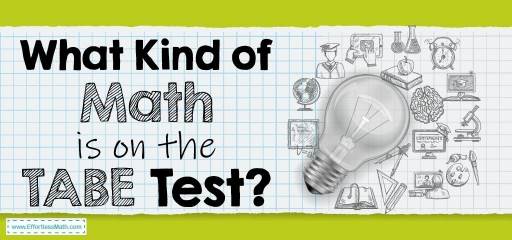
The Test of Adult Basic Education, or TABE, is a test to identify individuals’ abilities and aptitude levels. Many companies use this test to hire, promote or select people for important specialized positions.
The TABE test has the following three parts:
- Reading
- Mathematics
- Language
This test is very similar to the GED test and some people use it as a test to prepare for the GED test. Passing or not passing the TABE test is meaningless, but your score will have a big impact on your future success.
The TABE test has five levels: Literacy (L), Easy (E), Medium (M), Difficult (D), and Advanced (A). Each level of TABE has its range of scale scores that are aligned to specific NRS (National Reporting System) levels.
The TABE test has two mathematical sections, Math Computation and Applied Math, which allow the use of a calculator in the Applied Math section.
The TABE math test does not assess computational skills. What matters in this test is what solution you use to solve a problem and how you do it.
The Absolute Best Book to Ace the TABE Math Test
Exam materials in the math section of the TABE test include the following:
Basic mathematics topics
In this section, you should be able to choose the correct operation and master the math operation well. Understand equalities and inequalities correctly and be able to simplify and solve expressions correctly. Estimating and rounding numbers is also one of the skills that are important in this section. Estimating is useful when you need an answer quickly.
In the measurement section, you also deal with standards, calculations, formulas, and units. You need to be familiar with concepts such as length, area, volume, and be able to measure anything that can be quantified, such as time, weight, speed, force, density, mass, temperature, angles.
Geometry
The geometric concepts you need to know for the TABE Math test include finding points on the coordinate plane, lines and slopes, angles, polygons and their area and perimeter, the Pythagorean theorem, circles, and the area and circumference and volume of circles.
Data Analysis, Probability, and Statistics
In the Data Analysis section, familiarity with charts and tables is essential. You need to understand these charts and how to use the data in them. In statistics and probability, you are also dealing with statistical concepts. The important thing to know in this section is finding the central value of a set of data and it’s usually done by solving for the mean, median, or mode. Probability is also a mathematical concept for predicting or calculating the probability of an event occurring. Usually, a few questions from Probability are included in the TABE Math test.
Algebra
Knowing Algebraic concepts such as exponents, logarithms, radicals, polynomials, simplifying and factoring, linear and quadratic equations, functions, word problems is essential to get the desired score in the TABE mathematics section. In algebra, you should assign variables to unknowns instead of spaces or question marks, and use algebraic rules to solve algebraic expressions.
| math sections | topics | Numer of Questions | |
| #1 | basic mathematics topics | One-Step Equations, Multi-Step Equations, Graphing Single–Variable Inequalities, One-Step Inequalities, Multi-Step Inequalities, Systems of Equations | 14-16 |
| #2 | Geometry | Pythagorean Theorem, Triangles, Polygons, Trapezoids, Circles, Cubes, Rectangular Prism, Cylinder | 8-10 |
| #3 | Data Analysis, Probability, and Statistics | Simplifying Ratios, Proportional Ratios, Similarity and Ratios, Percentage Calculations, Percent Problems, Discount, Tax and Tip, Percent of Increase and Decrease, Simple Interest, Mean, Median, Mode, and Range, Histograms, Pie Graph, Probability Problems, Combinations, and Permutations | 6-8 |
| #4 | Algebra | Fractions and Decimals, Real Numbers and Integers, Algebraic Expressions, Linear Functions, Exponents and Radicals, Polynomials, Functions | 8-10 |
Best TABE Math Prep Resource for 2022
Complete List of TABE Math Topics
Fractions and Decimals
- Simplifying Fractions
- Adding and Subtracting Fractions
- Multiplying and Dividing Fractions
- Adding Mixed Numbers
- Subtracting Mixed Numbers
- Multiplying Mixed Numbers
- Dividing Mixed Numbers
- Adding and Subtracting Decimals
- Multiplying and Dividing Decimals
- Comparing Decimals
- Rounding Decimals
- Factoring Numbers
- Greatest Common Factor
- Least Common Multiple
Real Numbers and Integers
- Adding and Subtracting Integers
- Multiplying and Dividing Integers
- Order of Operations
- Ordering Integers and Numbers
- Integers and Absolute Value
Proportions, Ratios, and Percent
- Simplifying Ratios
- Proportional Ratios
- Similarity and Ratios
- Percentage Calculations
- Percent Problems
- Discount, Tax and Tip
- Percent of Increase and Decrease
- Simple Interest
Algebraic Expressions
- Simplifying Variable Expressions
- Simplifying Polynomial Expressions
- Translate Phrases into an Algebraic Statement
- The Distributive Property
- Evaluating One Variable Expressions
- Evaluating Two Variables Expressions
- Combining like Terms
Equations and Inequalities
- One-Step Equations
- Multi-Step Equations
- Graphing Single–Variable Inequalities
- One-Step Inequalities
- Multi-Step Inequalities
- Systems of Equations
Linear Functions
- Finding Slope
- Graphing Lines Using Standard Form
- Graphing Lines Using Slope-Intercept Form
- Writing Linear Equations
- Graphing Linear Inequalities
- Finding Midpoint
- Finding Distance of Two Points
Exponents and Radicals
- Multiplication Property of Exponents
- Division Property of Exponents
- Zero and Negative Exponents
- Powers of Products and Quotients
- Negative Exponents and Negative Bases
- Scientific Notation
- Radicals
Polynomials
- Writing Polynomials in Standard Form
- Simplifying Polynomials
- Adding and Subtracting Polynomials
- Multiplying Monomials
- Multiplying and Dividing Monomials
- Multiplying a Polynomial and a Monomial
- Multiplying Binomials
- Factoring Trinomials
- Operations with Polynomials
Geometry and Solid Figures
Statistics and Probability
Functions
- Function Notation
- Adding and Subtracting Functions
- Multiplying and Dividing Functions
- Composition of Functions
FAQs:
Is the TABE Math test hard?
This test is not difficult, but it can be very challenging if you do not have enough knowledge of the test materials.
How do I study for the TABE Math?
How you prepare for the TABE Math test is very important. You can use good prep books to prepare well for the TABE Math test. You can also use online practice tests for further practice after studying the TABE exam courses.
What happens if I fail the TABE test?
There is no passing or failing score on TABE. For more information, you can check here.
The Best Book to Ace the TABE Test
More from Effortless Math for TABE Test …
Is it hard to learn math for the TABE test?
Why not use top math education websites to improve your skills ?: Top 10 Free Websites for TABE Math Preparation
Tired of the usual methods for studying the TABE math test?
Experience TABE math test learning with our course !: The Ultimate TABE Math Course (+ FREE Worksheets & Tests)
Did you fail the TABE exam and are you worried about retaking it?
Join us to help you with some tips: Top 10 Tips You MUST Know to Retake the TABE Math
The Perfect Prep Books for the TABE Math Test
Have any questions about the TABE Test?
Write your questions about the TABE or any other topics below and we’ll reply!
Related to This Article
More math articles
- How to Create a Proportion? (+FREE Worksheet!)
- Unlock Your Potential: “HiSET Math for Beginners” Comprehensive Guide
- Is a Calculator Allowed on the CBEST Test?
- Treasure Hunt: How to Find Tax and Discount Using Percent of a Number
- How to Factor Numbers? (+FREE Worksheet!)
- Top 10 Tips to Overcome ATI TEAS 7 Math Anxiety
- Embark on Your SHSAT Math Adventure: Introducing the “SHSAT Math for Beginners” Solution Manual
- Classifying a Conic Section (in Standard Form)
- How to Use Elimination to Solve a System of Equations: Word Problems
- AFOQT Math-Test Day Tips
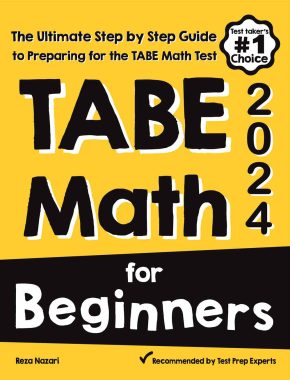
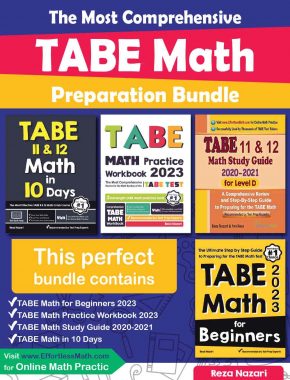
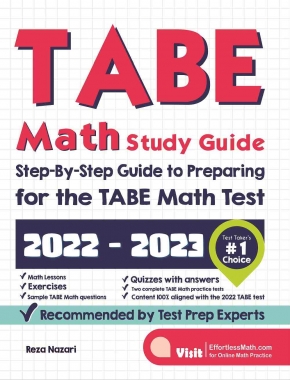
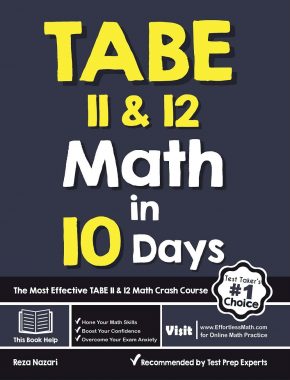
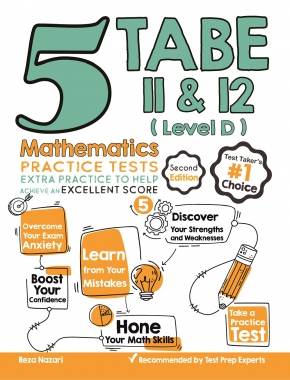
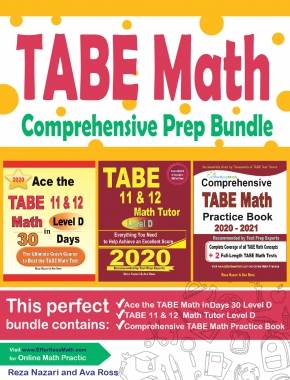
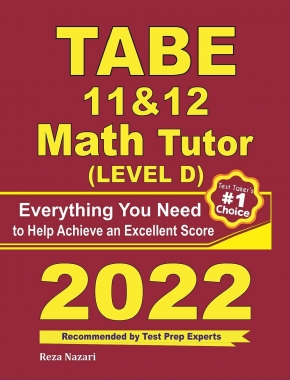
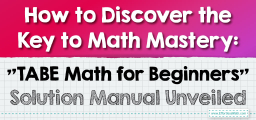
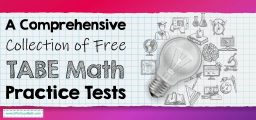
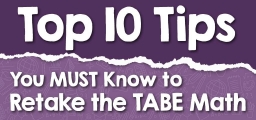

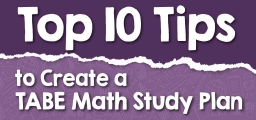



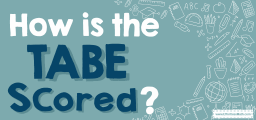

What people say about "What Kind of Math Is on the TABE Test? - Effortless Math: We Help Students Learn to LOVE Mathematics"?
No one replied yet.